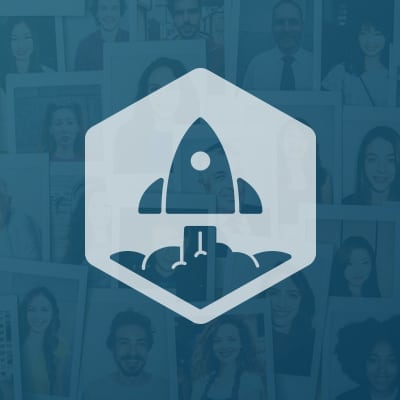When starting a company, M&As are probably not the first thing on your mind. However, it’s certainly something that you should think about and consider, even if your company doesn’t end up getting bought.
Villi Iltchev, Partner at August Capital, leads the conversation about the future of M&As in SaaS with Marc Teillon, Partner at Vista Equity; Emilie Choi, Head of Corporate Development at LinkedIn; and Monty Gray, Head of Strategy and Corporate Development at SAP.
Given their valuable experience with M&As, they give us their thoughts on the kinds of companies they look out for when buying, whether consolidation will be the new trend or fragmentation will be here to stay, the differences between buying on-premise businesses and cloud companies, and what’s changed in M&A over the past couple of years.
And if you haven’t heard: SaaStr Annual will be back in 2018, bigger and better than ever! Join 20,000 fellow founders, investors and execs for 3 days of unparalleled networking and epic learnings from SaaS legends like Jyoti Bansal, Aaron Levie, Josh James, and Dustin Moskovitz. If you don’t have tickets, lock in Early Bird pricing today and bring your team from just $499! (Prices go up June 1st.) Get tickets here.
TRANSCRIPT
Host: Please welcome, Villi Iltchev, partner at August Capital to the stage.
Villi Iltchev: Thanks for joining on us for this session. We have an amazing panel today. We’re going to talk mostly about M&A, which is how those of you that start companies make money usually.
Our panelists today are Marc Teillon. Marc is a partner at Vista Equity, which is the largest, the most active, and the most successful private equity firm in the software space. I don’t think I’m exaggerating.
We have Emilie Choi. Emilie Choi is the Head of Corporate Development at LinkedIn. She’s been leading the strategy team at LinkedIn and done a lot of interesting things.
Monty Gray is the Head of Strategy and Corporate Development at SAP. SAP has made successfully a transition from the on-premise development software world to the SaaS world, and I really look forward to hearing the insights about how those two worlds are different. With that, I figure we’ll get started.
Maybe Emilie, we can start with you. You’re pretty active at LinkedIn but you could always do more and be more active and do more deals. Can you shed some light into what was holding you back as a fast growing company in being more active with acquisitions and being more aggressive? What were the challenges you were facing?
Emilie Choi: First of all, I think, there may be a misperception in your mind with respect to how active we were. Actually, I think we were pretty active. We don’t disclose everything we do. I think you’re right in terms of the nature of the M&A that we have done has been predominately more tuck ins, which probably doesn’t get as much buzz as large, big name acquisitions.
I think if you just look at the roots of LinkedIn, our roots are a consumer company and we are an R&D led company and we’re also a network. We think about those attributes, we’re data driven, we are a collaborative culture. There’s just a lot of things that have to fit together in order for everything to work. There’s not this notion of you can just plug something in and it’s all just going to work on the network.
It’s actually something where we have to think about how it will fit into the whole picture.
That would be the one thing I would say is we’re very thoughtful in that regard. M&A unto itself is always one of those things where the stars have to align. That’s probably even more emphasized at company with our characteristics.
Villi: But it’s strategic. It fits so well. Why not do it? Why is it so hard?
Emilie: When you actually are on the inside of a company and you’re the acquirer and you’re talking about this stuff very thoughtfully with people who really care about making sure things go right, it is much easier to recognize…Actually, it’s much more responsible to just recognize when you don’t think you’re actually going to be able make something work the way you want it to.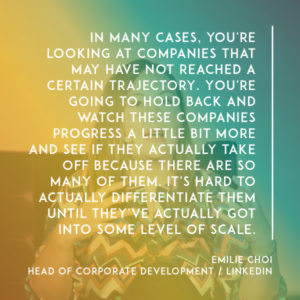
In many cases, especially with SaaS, you’re looking at companies that may have not reached a certain trajectory and you’re going to say, “It’s OK to hold back. It’s OK to watch these companies progress a little bit more and see if they actually take off because there’s such a plethora of them.” It’s hard to actually differentiate them until they’ve actually got into some level of scale.
Villi: Monty, what were the most insightful and stark differences in acquiring a traditional on-premise application software or infrastructure software company versus a cloud company?
Monty Gray: Besides valuation?
Villi: Besides valuation.
Monty: There’s different elements around. There’s financial elements just on the metrics and how you view the business, which are fundamentally different than on-premise. There’re technology elements, which are fundamentally different and then sales, end of the day, how do you sell to your customer? We’re not selling this traditional on prem world into the CIO office. We’re actually selling to a line of business to our end user.
These are all different ways to perceive the business than what SAP, let’s say, five years ago historically did. On the financial side, it goes back to growth. Is there healthy growth taking place? As a different lens, you have to apply when you’re looking at SaaS company versus an on-premise company.
Quality of bookings, new and up sell churn, customer acquisition cost, all the metrics which everybody is very familiar with here. Those are things that are unique and they’re there for a reason. We spend a lot of time looking at those and how did that translate into the on prem world.
At a macro level, there’s margins. It goes back to healthy growth and what are the margins to support that. Technology wise, there’s some good and some bad. One of the obvious things is you have more control over your technology stack when you’re acquiring a SaaS company.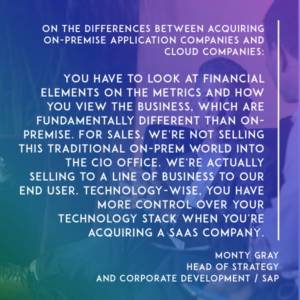
Therefore, in terms of packaging a software that’s a little bit less onus, that’s on you as the provider.
At the same time, when you look to scale a business, you have to ask yourself different questions. How do I take a business into a different geographic market, how to take your business to Europe, how to take it to Asia? You really quickly get into an infrastructure conversation, a data center strategy conversation. Things are fundamentally different from the thesis of why you would acquire company than, say, a traditional on-premise company.
Villi: Is your experience that acquiring a SaaS company has been more challenging than an on-premise company?
Monty: I think in the early years, let’s go back to five years ago, it was probably more challenging. That was primarily a reflection of SAP and who we were at that point of time. How we sold product, how we incentivized our sales and taking an acquired product and putting into that model.
Technology wise, what was our technology strategies for setting up a data center in Singapore, for example? These are different things that we matured and we’re at the point now where there’s no friction on that.
Villi: Marc, maybe from a private equity perspective, you have become more active in SaaS recently. You took Marketo Private. Marketo was one of the more successful and larger SaaS companies out there. What do you see in SaaS? Has anything changed? Has SaaS matured? What’s the SaaS world from your perspective as a private equity buyer?
Marc Teillon: From a maturity standpoint, I think, once the people that wear suit and ties show up, it means the market is pretty mature. We believe that this market is actually getting to a point where private equity can be successful.
I think in the Marketo example, we found that the TAM was still growing because it was moving from the SMB market to the enterprise and they had made significant investment in the sales there and also the customers were being more comfortable using SaaS applications.
For us, that was where we had primarily operated in with other software companies in the enterprise and we were very comfortable operating there. Cvent was another example of a great SaaS company that we took private, and these companies are of an appropriate scale for us to make investments.
Villi: What levers or opportunities do you see in SaaS to create value? In the traditional on-premise world, a lot of the opportunities to make money were cost savings. How is SaaS different and what levers do you think you have as the owner of these companies to generate returns?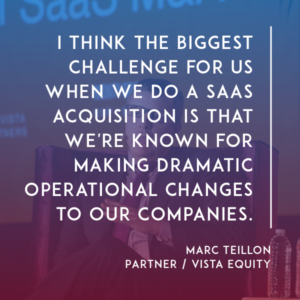
Marc: I think the biggest challenge for us when we do a SaaS acquisition is that we’re known for making dramatic operational changes to our companies. When you’re in an on-premise environment, the stickiness of those applications allows you to make what could be perceived as disruptive changes and still maintain that revenue stream.
In a SaaS environment, that is just not the case. The retention rates are just different. Applications are more portable. We have been very cognizant of that as we’ve done it and it’s caused us to reevaluate some of our playbook as we’ve gone into this marketplace but the core principles of certain schools and universities in regions of the country are overvalued in terms of how much we pay for coders. That’s one thing.
Another thing is that the way we compensate people. All those basic fundamental business practices still manifest themselves in SaaS world and we’ve been successful doing that at the companies that we’ve acquired.
Villi: Do you envision getting even more active in SaaS?
Marc: Yeah. I think the biggest challenge for us from a public company standpoint is we’ve taken a significant part of the market share out of the market. Now, I think you’ll see us more active with private SaaS companies.
Villi: Just for context, for those of you that don’t know Vista, Vista manages how many billion in assets?
Marc: Up to 29 billion.
Villi: 29 billion in assets. They have a lot of cash to deploy.
Monty, can we talk about size and scale for how you guys think about what is the right potential acquisition to make? SAP has made a lot of larger SaaS acquisitions, Ariba, SuccessFactors and Concur, $3 billion plus each of those acquisitions. Was that part of a deliberate strategy to focus on larger acquisitions or it just happened that way? Is there a difference?
Monty: I think that’s a great point. If you go back in terms of some historical context five years ago when we were looking to make, as a company, the transition to the cloud, we really looked to our customers to find out what they were using and who was out there.
There was a handful of large scale assets if you recall back five years ago, and success factors was one of them. It was a great anchor for us where our customers were using it, it was side by side. It was very synergistic for what we were doing.
That enabled us to understand the different aspects of the cloud from a selling perspective, from a back office perspective, how to manage a cloud business.
From there, we looked at what are the other ancillary areas, large horizontal topics. It was procurement, SRM procurements for Ariba, Travel, Concur. What are the really good quality assets out there that are synergistic to SAP?
We were pretty prescriptive about looking at that and thinking, here’s something that could make sense, and then ultimately we listened to our customers, and felt like this is the way they were going.
Going forward, if you look at where we are today, a good part of our organic portfolio is now SaaS. As a result of that, we had this combination of acquired property that you mentioned, the brands which we still maintain, and then different areas whether it’s finance, whether it’s in CRM, these are some of the organic aspects that we have that are now SaaS.
Looking forward, we look across our entire portfolio which is quite broad from a SaaS perspective relative to five years ago, and we look to see where are some things that could augment this now.
Villi: How do you look at a SaaS startup doing $10 to $20 million, or even $30, $40 million in ARR? How do you look at that? Does it need to be extremely strategic for you guys to act, or can you get yourself…Is a time going to come where we’re going to see SAP do two of those types of deals a month, or is there something else that plays into how you think about M&A strategy?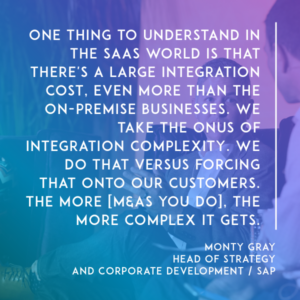
Monty: One thing to understand in the SaaS world, and you can do this with the larger assets, is there’s a large integration cost, even more than the on-premise businesses. We take the onus of integration complexity.
We do that versus, forcing that on to our customers. The more you go down that path, which you’re describing, the more complex it gets for us. Our customers are starting to demand that integration from us, and that becomes a complexity for us.
It’s hard to say when we’ll get there. We’re trying to be very prescriptive about what we do, and from a healthy growth perspective. 10 to 20 ARR type of center is interesting. One, you have a company that’s demonstrated product/market fit.
They demonstrated some eliminative execution and growth, and the question is, can you scale that up at a healthy clip, de-risking the integration part of it? We’re going to refer back to that paradigm, but we like to de-risk what we’re trying to do from a healthy growth perspective.
Villi: Emilie, you alluded a thing that there are lots of SaaS companies out there, it’s a crowded market, lots of great SaaS companies out there.
Do you think a time will come when SaaS is going to start consolidating, and we’re going to see more M&A activity, or do you think fragmentation is here to stay? Maybe you can elaborate on why you think either way.
Emilie: There’s a plethora of SaaS companies, because it’s just less expensive to develop those companies as opposed to on prem back in the day.
Again, it’s very hard to differentiate, at those very early stage levels, who is going to be the winner in those types of markets. What our experience has been, we’ll meet with a lot of the relevant, early stage companies that are tracking at those single digit or teens ARR.
The question is, do you try to get them early, and look at them as acquired and say, “We can take this, we can plug them into our sales team, we can have something bigger,” or do you wait, and see who will actually win that market in some regard.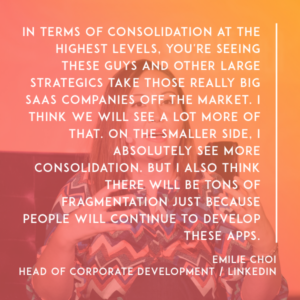
In terms of your question, where’s the consolidation, at the highest levels, you’re seeing these guys and other large strategics take those really big SaaS companies off the market, and I think we will see a lot more of that.
There’s not as many targets at that part of the market. On the smaller side, I absolutely see more consolidation. I think there will, maybe, tons of fragmentation just because people will continue to develop these apps.
At the same time, a lot of companies will have a day where they have to figure out what they’re actually going to do here, because they’re just not going to be able to scale beyond a certain place.
It’s much harder to get from that 10 million ARR to 20, to 50, to 100 than it was to get from 0 to 10. The best of those companies, the best of those teams will be picked up, and a lot of others will probably go away.
Villi: Monty and Marc, I’d love to get your feedback on this one as well. My impression is, observing the market, a lot of the acquisitions over the last 12 months had been on the high end of the market.
The larger properties have gotten acquired. We haven’t seen much going on in any startup that’s making less than say $80 million in ARR. We haven’t seen a whole lot of activity. In fact, I did some research yesterday, and the list is very thin.
Why is that? Why are we not seeing more activity? I read an article by Fred Wilson from Union Square predicting that this year, 2017, we’re going to start seeing consolidation and activity. Do you anticipate that? What’s holding it back?
Monty: To your first question, I think part of it is it’s a risky proposition to do a lot of these smaller deals, and to the extent, there’s a quality asset of scale that’s stems from the scale you de-risk your dollars you’re putting to work, so that’s probably part of the sentiments that’s happening there. I don’t know. I’d love to get the perspective from Vista.
Going forward, it’s hard to forecast what that’s going to look like. I get this question every year, do you see it increasing, or what’s going to happen? I’ll answer it this way. Overall, there’s a certain maturation that’s taken place in the SaaS world, SaaS is almost ubiquitous with enterprise software today.
When you ask that question around SaaS and M&A, it’s almost where do you see the enterprise software market taking place. It’s still a growth segment. It’s not yet at that stagnant segment.
Although, you and I have discussed this, there’re probably some cohorts where that’s happening, but by and large, this is still a growth cohort that we’re talking about here and the enterprise software we see it’s still a growth business. I still think there’ll be some healthy M&A going forward.
Marc: Yeah. We just raised a $500 million fund to go after the lower end of the market. We believe that there hasn’t been a lot of consolidation there. People focus on the market, and that’s a huge opportunity for us. I’m still not sure why, but we believe it’s a huge place for us to play.
Villi: What do you look for in those smaller, say $20, $10 to $15 million ARR businesses, what are the criteria…?
Marc: If we’re going to do it as a platform, we hope that it is an actual platform. [laughs] I’m sorry to use the term twice. If we’re going to make acquisitions as part of our broader Marketo or Cvent strategy, we’re going to be looking for features that we can actually sell into our install base.
We’ve been very successful at Vista over time buying a large install base of customers and buying technologies that we can sell into the install base. I think a lot on the smaller end of this companies that are $5 to $10 million of ARR, they really look a little bit more like features. This is actually a platform so you can leverage.
Villi: When you say a platform, I don’t mean to geek out, but I think about a company like Infor in the on-premise world which started as a boring ERP company, and then it became an amalgamation of 80 or whatever acquisitions that they bolted on to and then made it into a big company. Is that what you mean? Is that…?
Marc: I think even more as Marketo being a big opening platform.
Villi: A leader in a space that you can…got it.
Emilie, a question for you. What are the trade offs or the things you value at the different stages of a company’s progression? At the very early stage, obviously, there’s not a whole lot of revenue there. Maybe some IP.
Later on, maybe there are some customers. Later on, you obviously start to focus more on the metrics. Can you shed some light into how you assess a potential acquisition as the company matures?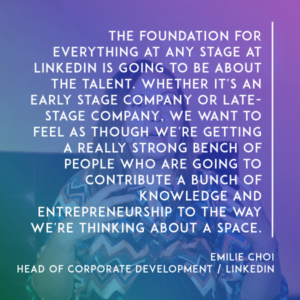
Emilie: I think very consistent with LinkedIn’s roots, the foundation for everything at any stage for us is going to be about the talent. The reason for that is that, whether it’s an early stage company or late stage company, we want to feel as though we’re getting a really strong bench of people who are going to contribute a bunch of knowledge and entrepreneurship to the way we’re thinking about a space.
For example, our four business plans are all run by acquired entrepreneurs, which is testament to that. I think we look at as the stages progress…in early days, we’re going to focus much more at the startup level on what is the quality of the technology to date because not necessarily that it’s going to be able to be deployed to all of our customers given the fact that it was built as a startup.
Was it built in a way that would be consistent with the way that we would think about the world? Whereas at the other extreme end, we’re going to be looking at the business fundamentals. We’re going to be looking much more at how have they delighted customers and what is it about their actual monetization metrics that’s just wowing us beyond belief?
I think it’s consistently throughout the whole time you’re looking at talent, but I think you care a lot more about the idea that in early stage, you’re going to want to integrate that company completely fully into your stack and they’re going to have consistent design and tech principles. At the later stages, more about like, “Do they have an amazing business that you feel like can stand on its own in a way?” even if you’re going to integrate it.
Villi: Marc, do you believe that we’re going to see private equity play a bigger role here? Obviously, you alluded to raising a fund. I think what I’m getting here is that LinkedIn is very deliberate as to what they do. They’re not going to embark on some consolidation strategy.
Monty, you’re alluding to the fact that…again, I get the sense you’re very deliberate about the deals you do. I don’t get the sense that there’s a play here where you can roll up a space. Do you think, Marc, there’s role for private equity to be more aggressive and take a wider swath at acquiring a bunch of these assets?
Marc: I think if they can manage the technology risk that Monty talked about in managing multiple clouds, the private equity firms have a lot of capital. The software has been a successful asset class in the space.
Everybody is hiring partners to go after software. Everybody wants to have some investment in the sector. I really believe you’ll see private equity play a much more active role in the sector going forward.
Villi: Let’s talk about that. I want to explore a little bit about what other levers that a private equity firm can put to create that type of value. SAP has a big sales force. They can maybe drive some top line revenue.
I’m not sure you can take a whole lot of cost out even though you own a bunch of technology. You can bring some operational discipline. Are there any other things you can do to create value? Also, can you speak to managing the multiple clouds? You alluded to it. What is the challenge there?
Marc: Yes, maybe I’ll just start with just the multiple levers. I think at Vista, we have a different approach to development. I think, I don’t know what it is at SAP or what it is at LinkedIn, but I know at Google, you’re allowed to spend 50 percent of your time working on a development project that has no revenue potential, it’s just something you’re interested in.
That’s not just how we run our businesses. Quite frankly, we’re not hiring kids out of Stanford and MIT potentially to work at our companies. It’s probably somebody from a computer science program that’s off the radar of probably SAP, and LinkedIn, and some other schools.
That frees up significant developer time or it frees up significant human resource time to work on other more profitable initiatives. That’s one example. Another example is just on the compensation side. We just comp people differently and focus on high margin products.
On managing the multiple clouds, we’re still figuring that out. That is something that we’re working with Marketo and Cvent on. Over time, we’ll have best practices around that. That is something that is definitely a lot different when we bought market share buying on-premise companies. It’s a new risk.
Villi: This is going to be last question. I would love for all of you to provide some insight. What advice would you give to the CEO or founder of a SaaS startup as they think about exiting through M&A? It could be specific or generic, but what should they be thinking 12 months in advance of a potential transaction, how to prepare to show in the best light to potential buyer?
Monty: I’ll go back to the different stages. The first one is, depending on where you are, when you’re in an acquisition conversation. Let’s assume you have a viable product market fit is already down there and it becomes an issue in execution. The biggest lens we’ll look at a company is around, obviously there’s all the diligence aspects, but scalability.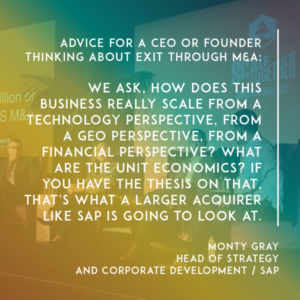
How does this business really scale from a technology perspective, from a geo perspective, from a financial perspective? What are unit economics? If you have the thesis on that, or at least have fine tune that a bit, that’s what a larger acquirer like us are going to go into. Our thesis is how do we scale this business?
Turn this into this feature, this unique business into something much larger whether it’s taking it to new geo or just putting into our sales channel and reducing that customer acquisition cost, but also taking it up market so, understanding those elements of it and having a firm perspective on it. It’s going to break at some point, but just have that plan for it, would be helpful.
Emilie: I would say yes. For me, I also think a lot of folks should be leveraging their VCs, leveraging their networks to get to know people like us earlier in the process when relevant. That doesn’t mean we can all spend a bunch of time together and you guys are building and we have a lot to look at to.
I think it’s more about starting to build that relationship early when it warrants it so that later it’s not just this reactive execution oriented thing. It’s more that we know how you guys are tracking. We know why you’re interesting and why you’re relevant. If that moment comes, then we’ll have already had that relationship in place.
Villi: Can I follow up on this? You have divergent views on whether startups should be talking to people like you to begin with.
Emilie: Yes, I’ve talked to Corp Dev.
Villi: The program famously says that talking to Corp Dev is a waste of time. What is the right cadence for startups to engage with you and stay in front of you?
Emilie: The best ones are, whether it’s the VC or somebody says like, “Hey, there’s nothing actionable. You should just have this company on your radar. They’re in your space. They’re doing some really interesting stuff. These are the metrics. Again, super early, but if at some point you want to grab coffee, you should.”
The reason that you should talk to Corp Dev at some point is because we’re the central hub where we can introduce that founder to the relevant folks in our company. If nothing else, they’re going to share what they’re going through and how they’re thinking about the world. You have another perspective on what you’re building and what everybody is seeing in the market.
It’s good for you to have a pulse on what other similar like minded product or sales leaders are thinking about as you’re building something out. There is an art to it. It’s not a science. The cadence shouldn’t be every month. It shouldn’t be even every quarter.
I think it’s just more like…I really appreciate it when a founder that I like will just shoot me a note and say like, “Hey, FYI, we should catch up at some point. We’ve been killing it with a bunch of new logos. You should just know about this because we pivoted the product a little bit.” Those updates are very valuable, even if it’s an email and we get to know them over time.
Villi: Marc?
Marc: I think we tell our companies, “Build a great company. Don’t build a company that looks great at exit. Don’t chase trends. Focus on profitable growth. Focus on great NPS scores for your customers. Focus on really good defensible technologies.”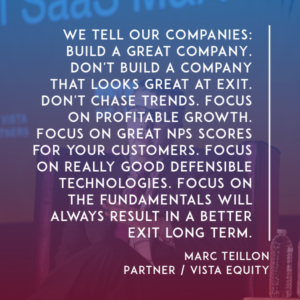
I think a lot of people end up chasing trends and doing unnatural things because they think it’s going to result in a better valuation if they magically get public or because some VC that they’re talking to might be looking for this certain contract. It might not necessarily be what’s best for the business. Focus on the fundamentals will always result in a better exit long term.
Villi: Marc, I’m pretty sure that everybody in this room knows how to get in touch with Emilie or Monty, how do you reach out to Vista? Who do you talk to? Should you go through a banker? How do we…?
Marc: If you’re interested, we have on our website our email addresses are on there. You can just send us an email. We have a business development team as well led by a guy named, Lou Marchetti. You can reach out to me. You can reach out to Lou, and also talk to bankers as well. We’re happy to take the call.
Villi: Great. Well, thank you very much for doing this. I really appreciate it. I hope it was informative and insightful. Thank you for joining.

